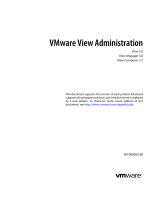
5 Wyse Datacenter Appliance XC for vWorkspace
6.2 Performance Tuning ..................................................................................................................................................... 49
6.3 Integrating SCVMM, Nutanix, and Microsoft Failover Cluster ............................................................................... 50
6.4 Integrating vWorkspace with SCVMM ....................................................................................................................... 56
7 Configuring Microsoft Failover Cluster ................................................................................................................................ 58
7.1 MS Failover Cluster Quorum ....................................................................................................................................... 58
7.2 Setting up MS Failover Cluster Network ................................................................................................................... 58
7.3 Adding Management VMs as Highly Available VMs ................................................................................................ 59
8 Configuring vCenter ............................................................................................................................................................... 60
8.1 Integrating vCenter and Nutanix ............................................................................................................................... 60
8.2 Integrating vWorkspace with vCenter ...................................................................................................................... 60
9 Floating vs Dedicated Management ..................................................................................................................................... 62
10 Deploying Virtual Desktops .................................................................................................................................................... 63
10.1 Desktop Template (Gold Image) Setup ..................................................................................................................... 63
10.1.1 Template VM Creation ................................................................................................................................................. 63
10.1.2 Creating VHDX for Hyper-V ........................................................................................................................................ 64
10.1.3 Creating Desktop VMs for the vSphere hypervisor configuration........................................................................ 65
10.1.4 Installing Desktop OS and Application ...................................................................................................................... 65
10.1.5 Installing vWorkspace Agent ....................................................................................................................................... 65
10.1.6 Optimizing Desktop OS ............................................................................................................................................... 66
10.2 Adding Desktop Template to SCVMM ....................................................................................................................... 67
10.3 Adding Desktop Template to vCenter ....................................................................................................................... 68
10.4 Creating a Computer Group and Provisioning Desktops ...................................................................................... 68
11 Deploying Shared Sessions (RDSH) ...................................................................................................................................... 72
11.1 Setting up Shared Session (RDSH) ............................................................................................................................. 72
11.1.1 Creating RDSH VM Template ...................................................................................................................................... 72
11.1.2 Installing RDSH Role and User Applications ............................................................................................................. 73
11.2 Adding RDSH Template to SCVMM ........................................................................................................................... 75
11.3 Adding RDSH Template to vCenter ........................................................................................................................... 76
11.4 Creating RDSH Computer Group .............................................................................................................................. 76
12 Using the VDI Environment.................................................................................................................................................... 78
12.1 Creating Managed Application and Assigning Users and Groups ........................................................................ 78
12.2 Connecting to vWorkspace......................................................................................................................................... 79





















